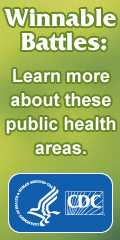May 2014
Did You Know? is a weekly feature from the Office for State, Tribal, Local and Territorial Support to inform your prevention activities. We invite you to read, share, and take action!
View the Current Did You Know?
May 30, 2014
- Foodborne illness is a significant problem in the United States, but addressing environmental causes can help prevent it.
- Each year roughly 1 in 6 Americans (or 48 million people) gets sick, 128,000 are hospitalized, and 3,000 die from foodborne diseases.
- You can take CDC’s free e-learning course on assessing environmental causes of foodborne illness outbreaks. States and localities can also register for CDC’s new surveillance system to collect data from environmental assessments.
May 23, 2014
- More than 9% of 12- to 17-year-olds had at least one major depressive episode in the past year, according to a 2012 national survey. Major depressive episodes were three times higher among females [PDF-3.4MB] than males.
- Behavioral Health Barometer: United States, 2013 [PDF-3.4MB] provides a snapshot of the state of mental health in the nation and data on the use of mental health treatment services.
- You can go to MentalHealth.gov to find local experts and a toolkit for holding community conversations about mental health.
May 16, 2014
- Almost 5,000 people visited US emergency departments in 2012 after inhaling pool chemical fumes or dust or splashing pool chemicals into their eyes. Pool operators and owners can help prevent these injuries.
- For 2009–2010, 28 states and Puerto Rico reported 81 disease outbreaks caused by swimming in contaminated water. Swimmers and parents can help prevent illness and outbreaks.
- Pool operators, pool owners, swimmers, parents, and health departments can promote healthy and safe swimming using free materials from CDC.
May 9, 2014
- According to the new CDC Vital Signs report, nearly half of adults with disabilities get no aerobic physical activity—an important health behavior to help avoid and manage many chronic diseases.
- Adults aged 18–64 years who have a disability and get no aerobic physical activity are 50% more likely to have heart disease, stroke, diabetes, or cancer than those who get the recommended amount of physical activity.
- Doctors and other health professionals can use CDC’s physical activity and disabilities resources page to recommend physical activity among adults with disabilities.
May 2, 2014
- Nearly 9 out of 10 pregnant women in the United States take at least one medication.
- Because pregnant women are often excluded from medication studies, there is limited information about medication safety during pregnancy. Only 9% of medications have enough information to determine their risk to the baby, making treatment decisions difficult.
- CDC’s prescription for this problem—Treating for Two—is a national strategy to improve the health of mothers and babies through safer medication use in pregnancy.
Did You Know? information and web links are current as of their publication date. They may become outdated over time.
- Page last reviewed: November 9, 2015
- Page last updated: October 14, 2016
- Content source:



 ShareCompartir
ShareCompartir



